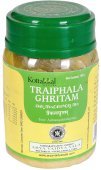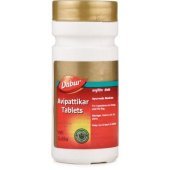Vibhitaki, Vibhītakī: 6 definitions
Introduction:
Vibhitaki means something in Hinduism, Sanskrit, Buddhism, Pali, biology. If you want to know the exact meaning, history, etymology or English translation of this term then check out the descriptions on this page. Add your comment or reference to a book if you want to contribute to this summary article.
In Hinduism
Ayurveda (science of life)
Dietetics and Culinary Art (such as household cooking)
Source: Shodhganga: Dietetics and culinary art in ancient and medieval IndiaVibhītakī (विभीतकी) refers to a type of fruit-bearing plant, according to the Bhelasaṃhitā, and is commonly found in literature dealing with the topics of dietetics and culinary art, also known as Pākaśāstra or Pākakalā.—We can see the description of flowering and fruit bearing plants in Ṛgveda. But we come across the specific names of them only in the later Saṃhita and Brāhmaṇa literature. [...] Bhela especially recommends the use of āmalaka before food, hārītakī after the food and vibhītakī after the digestion of the food.
Kalpa (Formulas, Drug prescriptions and other Medicinal preparations)
Source: Shodhganga: Edition translation and critical study of yogasarasamgrahaVibhītakī (विभीतकी) is another name for “Akṣa” and is dealt with in the 15th-century Yogasārasaṅgraha (Yogasara-saṅgraha) by Vāsudeva: an unpublished Keralite work representing an Ayurvedic compendium of medicinal recipes. The Yogasārasaṃgraha [mentioning vibhītakī] deals with entire recipes in the route of administration, and thus deals with the knowledge of pharmacy (bhaiṣajya-kalpanā) which is a branch of pharmacology (dravyaguṇa).
Unclassified Ayurveda definitions
Source: Ancient Science of Life: Snake bite treatment in Prayoga samuccayamVibhītaki (विभीतकि) refers to a medicinal plant known as Terminalia bellirica, and is used in the treatment of poison (viṣa), according to the 20th century Prayogasamuccaya (one of the most popular and widely practised book in toxicology in Malayalam).—[...] Root of Nīlī (Indigofera tinctoria) ground in juice of Nīlī itself, rolled into the size of the fruit of Vibhītaki (Terminalia bellirica) and dried is given with milk. If vomiting occurs immediately, prognosis is good. If not, its asādhya (incurable). [...] Symptoms of impending death are also mentioned in the first chapter.

Āyurveda (आयुर्वेद, ayurveda) is a branch of Indian science dealing with medicine, herbalism, taxology, anatomy, surgery, alchemy and related topics. Traditional practice of Āyurveda in ancient India dates back to at least the first millenium BC. Literature is commonly written in Sanskrit using various poetic metres.
Biology (plants and animals)
Source: Google Books: CRC World Dictionary (Regional names)Vibhitaki in India is the name of a plant defined with Terminalia bellirica in various botanical sources. This page contains potential references in Ayurveda, modern medicine, and other folk traditions or local practices It has the synonym Myrobalanus laurinoides (Teijsm. & Binn.) Kuntze (among others).
Example references for further research on medicinal uses or toxicity (see latin names for full list):
· Novae Plantarum Species (1821)
· Hooker’s Journal of Botany Kew Gard. Misc. (1851)
· De Fructibus et Seminibus Plantarum (1791)
· Plants of the Coast of Coromandel (1805)
· Flora of the British India (1878)
· Plant Systematics and Evolution (1996)
If you are looking for specific details regarding Vibhitaki, for example pregnancy safety, diet and recipes, extract dosage, health benefits, side effects, chemical composition, have a look at these references.

This sections includes definitions from the five kingdoms of living things: Animals, Plants, Fungi, Protists and Monera. It will include both the official binomial nomenclature (scientific names usually in Latin) as well as regional spellings and variants.
Languages of India and abroad
Pali-English dictionary
Source: BuddhaSasana: Concise Pali-English Dictionaryvibhītakī : (f.) Beleric Myrobalan.

Pali is the language of the Tipiṭaka, which is the sacred canon of Theravāda Buddhism and contains much of the Buddha’s speech. Closeley related to Sanskrit, both languages are used interchangeably between religions.
Sanskrit dictionary
Source: DDSA: The practical Sanskrit-English dictionaryVibhītakī (विभीतकी).—Name of tree, Terminalia Belerica, one of the three myrobalans.
See also (synonyms): vibhīta, vibhītaka.
Sanskrit, also spelled संस्कृतम् (saṃskṛtam), is an ancient language of India commonly seen as the grandmother of the Indo-European language family (even English!). Closely allied with Prakrit and Pali, Sanskrit is more exhaustive in both grammar and terms and has the most extensive collection of literature in the world, greatly surpassing its sister-languages Greek and Latin.
See also (Relevant definitions)
Partial matches: Vibhitaka, I.
Query error!
Full-text: Vibhitaka, Vibhita, Triphala, Haritaki, Dantadhavana, Amalaka.
Relevant text
Search found 13 books and stories containing Vibhitaki, Vibhitaka-i, Vibhītaka-ī, Vibhītakī; (plurals include: Vibhitakis, is, īs, Vibhītakīs). You can also click to the full overview containing English textual excerpts. Below are direct links for the most relevant articles:
International Ayurvedic Medical Journal
Antibacterial activity of vibhītakī kṣāra [terminalia bellirica (gaertn.) roxb.] on chronic wound microbiota against mupirocin- a comparative in vitro study < [2022, Issue 11 November]
A clinical study to evaluate the efficacy of alambushadi ghan vati in the management of amavat w.s.r.to rheumatoid arthritis < [2022, Issue 1, January]
Role of punarnavadi mandura in hypothyroidism- a critical review < [2023, Issue 01 January]
Aragvādādi kaṣāyam and Syrup Talekt caused skin rashes. < [Volume 33 (issue 3), Jan-Mar 2014]
Efficacy of herbomineral compounds in managing Yakṛt Roga. < [Volume 34 (issue 4), Apr-Jun 2015]
Microscopic identification of curna, kvatha, lehya, and rasayana ingredients. < [Volume 1 (issue 1), Jul-Sep 1981]
World Journal of Pharmaceutical Research
Study of Vibhitaki (Terminalia bellirica) in Saptavidha Kashaya < [2022: Volume 11, July issue 9]
Pharmacognostic and phytochemical study of Anubhuta Rasayan for retinopathy. < [2016: Volume 5, July issue 7]
Analytical study of nimbadi taila - an ayurvedic formulation < [2022: Volume 11, February issue 2]
Mahabharata (English) (by Kisari Mohan Ganguli)
Section LXXII < [Nalopakhyana Parva]
Garuda Purana (by Manmatha Nath Dutt)
Chapter CXCV - Medical treatment of female complaints < [Dhanvantari Samhita]
Puranic encyclopaedia (by Vettam Mani)
Related products
(+3 more products available)





